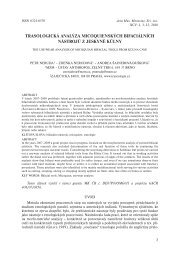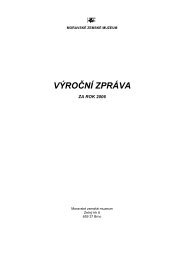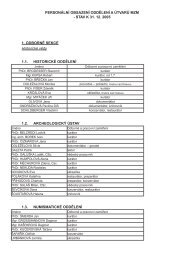Heft Ljubljana - Hugo Obermaier Gesellschaft
Heft Ljubljana - Hugo Obermaier Gesellschaft
Heft Ljubljana - Hugo Obermaier Gesellschaft
You also want an ePaper? Increase the reach of your titles
YUMPU automatically turns print PDFs into web optimized ePapers that Google loves.
that the ”complete” points on this site were either conjoined by us or they were clearly unfinished. The<br />
small size of bifacial artefacts known from many sites can result from:<br />
- reduction in mass due to their use and subsequent reutilization,<br />
- the initial small size of the blank,<br />
- different functions.<br />
A tool reparation is difficult to capture in the chaine opératoire. It can be distinguished by a detailed<br />
analysis of negative surfaces whose edges and orientation are gradually obliterated during the tool recycling<br />
process (Pastoors 2000, 247). This can be a common problem in surface collections. For this reason,<br />
we focused on reparation traces which are clearly demonstrable by refitting; in several cases we were<br />
able to reclassify some items as repaired, even broken artefacts where thinning strokes were directed<br />
from fracture surface to one or both sides with preserved negative bulbs and same patina as the rest of<br />
the tool.<br />
Reshaping due to reutilization leads to changes in artefact size and shape which, in some cases, can lead<br />
to type reclassification (e.g Dibble 1988; 1995, 300). The assemblage composition may then appear inhomogeneous<br />
and may cause that the different artefacts in the same assemblage are classified as culturally<br />
or chronologically separate (sometimes reasonably; Vencl 2007, 59).<br />
Based on preliminary conclusions, we infer that the shape and metric variability of studied leaf points<br />
are determined by the level of use; it means the number of reutilization cycles and the size of the initial<br />
blank. The most common shapes are semi-leaf and sub-leaf forms with rounded bases or even proximal<br />
ends which probably resulted from reparation of damaged or blunted tip(s). The primary aim of fasonage<br />
is a point sharpened from both sides made by fashioning of ovoid or irregular shapes. Leaf points<br />
were multifunctional tools whose social status tends to be overemphasised in the workshop region of<br />
Krumlovský Les.<br />
The use-wear analysis was performed on selected artefacts from two excavated stratified Szeletian sites:<br />
Moravský Krumlov IV-3 (17 pieces) and Vedrovice V (29 pieces). Raw material included chert (Krumlovský<br />
Les), radiolarite and flint. Possible use-wear traces were identified on 1 piece from Moravský<br />
Krumlov and 16 pieces from Vedrovice.<br />
The traces were interpreted as hide processing (transversal motion) on one piece from Moravský Krumlov<br />
and one piece from Vedrovice. Other 2 pieces from Vedrovice were used for scraping undefined materials<br />
of soft and medium hardness and might have also been used for hide processing. It was not possible<br />
to interpre them more precisely due to the presence of a thick patina on the tool surfaces. Another<br />
relatively common trace type, which probably resulted from use-wear, was located on the tips of some<br />
leaf points (7 pieces from Vedrovice). It probably originated from dynamic activities. However, as no<br />
impact fractures were identified on these pieces, the limited degree of polish might also origin in postdepositional<br />
factors. Two pieces showed faint longitudinal traces of contact with unspecified material of<br />
soft or medium hardness (2 leaf points from Vedrovice V). Three pieces displayed traces of boring/piercing<br />
with material of medium hardness (2 leaf points from the Vedrovice collection and 1 from<br />
the Moravský Krumlov set). Finally, two pieces displayed undeveloped traces from undefined materials.<br />
The results of the analysis confirm that both sites had different archaeological contexts and functions. In<br />
addition, the results show that the leaf points, defined as a single typological group, must be understood<br />
as multi-functional tools. It can be assumed that the traces originating in working meat/hide or soft<br />
vegetables might have been lost or underestimated due to the high degree of patination on most of the<br />
analysed pieces.<br />
(Project under Czech Ministry of Culture, No. DE07P03OMG011).<br />
References:<br />
Chabai, V.P., Demidenko, Y.E. 1998: The classification of flint artifacts. In: A.E. Marks – V.P Chabai<br />
(eds.): The Middle Paleolithic of Western Crimea, Vol. 1. ERAUL N o 84, 31-51. Liège.<br />
Dibble, H.L. 1988: The interpretation of Middle Paleolithic scraper reduction patterns. In: L. R.<br />
Binford - J.-P. Rigaud (eds.): L‘Homme de Neandertal Volume 4: La Technique. ERAUL N o 31,<br />
61-76. Liège.<br />
Flas, D. 2008: La transition du Paléolithique moyen au supérieur dans la pline septentrionale de l’ Europe.<br />
Anthropologica et Praehistorica 119, 5-254.<br />
30





